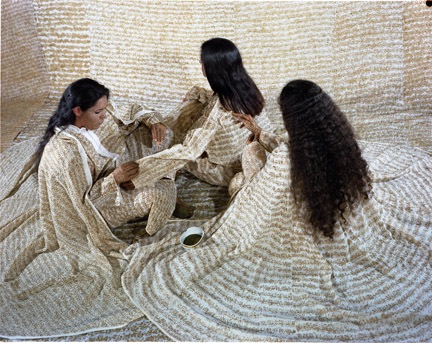About the Photographer
Essaydi, Lalla
Morroccan, b. 1956
According to Islamic tradition public spaces are a male domain and women are largely limited to the private sphere. In the "Converging Territories" series, Lalla Essaydi makes large-scale photographs of Moroccan women within a stylized domestic space. Essaydi challenges the traditional social boundaries and gender dynamics by writing calligraphy in henna across women's clothes, their skin wherever it is visible, and every inch of their surroundings. She states, "In photographing women inscribed with henna I emphasize their decorative role, but subvert the silence of confinement. These women 'speak' visually to the house and to each other, and create a space that is both hierarchical and fluid. Furthermore, the calligraphy, a sacred Islamic art form inaccessible to women, constitutes an act of rebellion. Applying such writing in henna, a form of adornment considered 'women's work,' further underscores the subversiveness of the act."
In Converging Territories #11 (2006), three women are pictured sitting on the ground. Two of the women turn away from the camera, and thus from the viewer, while the third woman writes calligraphy on the others' clothing. Their heads are not veiled and their long hair is visible, but their bodies are covered by robes that spread out around them like ripples in a pond. Their attire merges with the hanging cloth around them, and the calligraphy effectively continues from their clothing to their immediate surroundings, uniting their bodies with the domestic space. The artist describes the daily life of Muslim women as an ongoing cultural negotiation, and her photographs enact a negotiation of their own, between longstanding traditions and a growing culture of Islamic feminism, and between private lives and public expression.
The photographs and the text appearing in them—which was conceived and written by the artist—have an autobiographical element as well. Essaydi grew up in Morocco and spent years in Saudi Arabia before moving to the United States. Morever, the setting for her photographs is a large house in Morocco, belonging to her extended family, where the artist was occasionally sent for punishment as a child if she left the "permissable spaces" available to her as a female. Essaydi sees her personal experience—as an artist, as Moroccan, as Saudi, as traditionalist, as liberal, as Muslim—as multiple lenses through which to consider the complexities of Arab female identity and as a means to resist stereotypes. She describes how she now inhabits a different kind of space than she did as a child—as an Arab woman living in the Western world—while still carrying the house within her as an internalized space of "converging territories." Just as the artist describes the daily life of Muslim women as an ongoing cultural negotiation, her photographs outline a negotiation of their own, between longstanding traditions and a growing culture of Islamic feminism, and between private lives and public expression.
Lalla Essaydi works in a range of media, including photography, video, and painting. She received a BFA from Tufts University, Medford, Massachussetts in 1999 and an MFA from the School of the Museum of Fine Arts and Tufts University in 2003.
